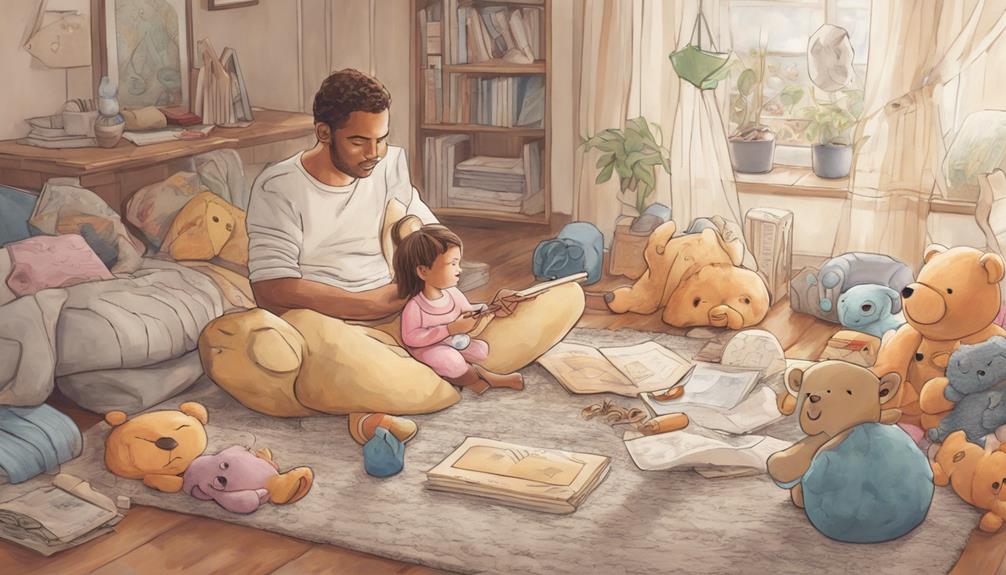Facing the challenges of divorce can be difficult, but it is crucial to support your children as they navigate this transition for their well-being and happiness. Imagine a comprehensive guide offering practical advice and emotional support tailored to your child’s individual needs.
This comprehensive resource delves into strategies that can make a significant impact on your child's emotional resilience and adjustment during this turbulent time. By exploring effective communication techniques, emotional support strategies, and post-divorce adjustment tips, you can empower yourself to navigate this difficult journey with your child's best interests at heart.
Key Takeaways
- Tailor communication to child's age for better understanding
- Acknowledge and validate children's feelings
- Maintain relationships with both parents
- Look out for changes in behavior or mood
Age-Appropriate Communication Strategies
When preparing children for divorce, it's crucial to tailor your communication strategies to their age to ensure they understand and process the information effectively. Children of different developmental stages will have varied levels of comprehension regarding divorce. Younger children may struggle with abstract concepts, so using simple language and concrete examples can help them grasp the situation better.
Encouraging open dialogue and creating a safe space for children to express their thoughts and feelings can provide them with the emotional support they need during this uncertain time.
As children face the anxiety and uncertainty that divorce brings, offering age-appropriate information about the changes that will occur post-divorce can alleviate some of their fears. Understanding and catering to their cognitive abilities is essential. Visual aids can be particularly helpful in explaining complex ideas related to divorce.
Managing Children's Emotions Effectively

To effectively support your children through the emotional challenges of divorce, it's crucial to acknowledge and validate their feelings while creating a safe space for open communication. Your child may experience a range of emotions during this transition, and it's essential to help them navigate these feelings with care and understanding.
How to Manage Your Child's Emotions Effectively:
- Acknowledge and Validate: Let your child know that their feelings are valid and that it's okay to feel sad, confused, or angry about the divorce.
- Encourage Open Communication: Create an environment where your child feels comfortable expressing their emotions and thoughts about the situation without fear of judgment.
- Provide Consistent Support: Offer reassurance and comfort to help your child cope with the changes and uncertainties that come with divorce.
Coping Mechanisms for Children During Divorce
Children often rely on various coping mechanisms, such as expressing their emotions through art, play, or writing, to navigate the challenges of divorce. Encouraging children to maintain relationships with both parents supports their emotional well-being. Providing a stable routine helps children feel secure amidst the changes divorce brings. Reassurance and validation of their feelings can aid children in coping effectively. Seeking professional support like counseling can assist children in developing healthy coping strategies during divorce.
| Coping Mechanisms | Description |
|---|---|
| Art, Play, Writing | Expressing emotions creatively can be therapeutic for children. |
| Maintain Relationships | Having connections with both parents can provide support. |
| Stable Routine | Predictability in daily life can offer a sense of security. |
| Reassurance and Validation | Affirming feelings helps children navigate their emotions. |
| Professional Support | Counseling or therapy can aid in developing coping strategies. |
Support your child by encouraging their creative outlets, maintaining stable routines, validating their emotions, and seeking professional help when needed.
Building a Supportive Environment for Children

Navigating the challenges of divorce can be significantly eased for children when they're surrounded by a supportive environment that prioritizes stability, reassurance, and open communication. Creating a safe and nurturing space for children during this tumultuous time is crucial for their emotional well-being and adjustment.
To build a supportive environment for children during divorce, consider the following:
- Maintain Consistency: Keeping routines as stable as possible can provide children with a sense of security amidst the changes happening in their family.
- Encourage Open Communication: Creating a space where children feel comfortable expressing their feelings and concerns can help them process their emotions effectively.
- Seek Professional Support: In cases involving complex legal issues such as custody arrangements, domestic violence, or disputes over parenting plans, consulting a knowledgeable divorce lawyer or mediator can ensure that decisions are made in the best interest of the children involved.
Helping Children Adjust Post-Divorce
Creating a stable and nurturing environment for your children post-divorce is essential for their emotional well-being and successful adjustment. After a divorce, focusing on your children's needs and emotions is crucial. Consistent care, stability, and open communication can help them navigate this difficult time. Here are some key aspects to consider in helping your children adjust post-divorce:
| Signs of Distress | Good Parenting | Legal Help |
|---|---|---|
| Look out for changes in behavior or mood. Seek professional guidance if needed. | Maintain a loving and supportive relationship with your children. Listen to their concerns. | Consult with legal experts to ensure custody arrangements and child support are in the best interests of your children. |
Frequently Asked Questions
At What Age Is a Child Most Affected by Divorce?
You're most affected by divorce between ages 9 to 11. Your developing ability to understand complex feelings could lead to fear and sadness. It's essential to offer extra support during this time.
What Not to Say to Kids During Divorce?
Hey there, during divorce, steer clear of blaming the other parent, discussing adult stuff, making false promises, asking kids to pick sides, or downplaying their feelings. Respect their emotions and keep communication open.
What Type of Therapy Is Best for Children Going Through Divorce?
For children going through divorce, therapy options like play therapy, CBT, family therapy, art therapy, and trauma-focused therapy can help express emotions, reframe negative thoughts, improve relationships, and process distress in a supportive environment.
What Is the Hardest Part of Divorce for Kids?
The hardest part of divorce for kids is feeling torn between parents, navigating new family dynamics, and coping with the emotional fallout. Your support, understanding, and reassurance play a crucial role in helping them cope.
Conclusion
You've equipped yourself with the tools to guide your children through the storm of divorce. Just like a lighthouse guides ships safely to shore, your support and understanding will navigate your children through the tumultuous waters of change.
Stay strong, stay compassionate, and remember that your love and guidance will be the beacon of hope that leads them to calmer seas ahead. You've got this, and your children will thank you for it.











